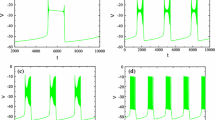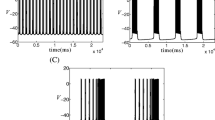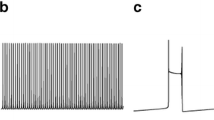Abstract
Activity of neurons in the pre-Bötzinger complex (pre-BötC) within the mammalian brainstem drives the inspiratory phase of the respiratory rhythm. Experimental results have suggested that multiple bursting mechanisms based on a calcium-activated nonspecific cationic (CAN) current, a persistent sodium (NaP) current, and calcium dynamics may be incorporated within the pre-BötC. Previous modeling works have incorporated representations of some or all of these mechanisms. In this study, we consider a single-compartment model of a pre-BötC inspiratory neuron that encompasses particular aspects of all of these features. We present a novel mathematical analysis of the interaction of the corresponding rhythmic mechanisms arising in the model, including square-wave bursting and autonomous calcium oscillations, which requires treatment of a system of differential equations incorporating three slow variables.












Similar content being viewed by others
References
Adams, W.B., & Benson, J.A. (1985). The generation and modulation of endogenous rhythmicity in the aplysia bursting pacemaker neurone r15. Progress in Biophysics and Molecular Biology, 46(1), 1–49.
Bertram, R., Sherman, A., Satin, L.S. (2010). Electrical bursting, calcium oscillations, and synchronization of pancreatic islets. Advances in Experimental Medicine and Biology, 654, 261–279.
Best, J., Borisyuk, A., Rubin, J., Terman, D., Wechselberger, M. (2005). The dynamic range of bursting in a model respiratory pacemaker network. SIAM Journal on Applied Dynamical Systems, 4(4), 1107–1139.
Butera, R., Rubin, J., Terman, D., Smith, J. (2005). Oscillatory bursting mechanisms in respiratory pacemaker neurons and networks. In S. Coombes & P. Bressloff (Eds.), Bursting: the genesis of rhythm in the nervous system. Singapore: World Scientific.
Butera, R.J. Jr., Clark, J.W. Jr., Canavier, C.C., Baxter, D.A., Byrne, J.H. (1995). Analysis of the efects of modulatory agents on a modeled bursting neuron: dynamic interactions between voltage and calcium dependent systems. Journal of Computational Neuroscience, 2(1), 19–44.
Butera, R.J. Jr., Rinzel, J., Smith, J.C. (1999). Models of respiratory rhythm generation in the pre-Bötzinger complex. I. Bursting pacemaker neurons. Journal of Neurophysiology, 82(1), 382–397.
Chay, T.R., & Keizer, J. (1983). Minimal model for membrane oscillations in the pancreatic beta-cell. Biophysical Journal, 42(2), 181–190.
Crowder, E.A., Saha, M.S., Pace, R.W., Zhang, H., Prestwich, G.D., Del Negro, C.A. (2007). Phosphatidylinositol 4,5-bisphosphate regulates inspiratory burst activity in the neonatal mouse pre-Bötzinger complex. The Journal of Physiology 582(3), 1047–1058.
Csercsik, D., Farkas, I., Hrabovszky, E., Liposits, Z. (2012). A simple integrative electrophysiological model of bursting GnRH neurons. Journal of Computational Neuroscience, 32(1), 119–136.
Del Negro, C.A., Hayes, J.A., Rekling, J.C. (2011). Dendritic calcium activity precedes inspiratory bursts in pre-Bötzinger complex neurons. The Journal of Neuroscience, 31(3), 1017–1022.
Del Negro, C.A., Koshiya, N., Butera, R.J., Smith, J.C. (2002a). Persistent sodium current, membrane properties and bursting behavior of pre-Bötzinger complex inspiratory neurons in vitro. Journal of Neurophysiology, 88(5), 2242–2250.
Del Negro, C.A., Morgado-Valle, C., Feldman, J.L. (2002b). Respiratory rhythm: an emergent network property? Neuron, 34(5), 821–830.
Del Negro, C.A., Morgado-Valle, C., Hayes, J.A., Mackay, D.D., Pace, R.W., Crowder, E.A., Feldman, J.L. (2005). Sodium and calcium current-mediated pacemaker neurons and respiratory rhythm generation. The Journal of Neuroscience, 25(2), 446–453.
Doi, A., & Ramirez, J.M. (2008). Neuromodulation and the orchestration of the respiratory rhythm. Respiratory Physiology & Neurobiology, 164(1–2), 96–104.
Doi, A., & Ramirez, J.M. (2010). State-dependent interactions between excitatory neuromodulators in the neuronal control of breathing. The Journal of Neuroscience, 30(24), 8251–8262.
Duan, W., Lee, K., Herbison, A.E., Sneyd, J. (2011). A mathematical model of adult gnrh neurons in mouse brain and its bifurcation analysis. Journal of Theoretical Biology, 276(1), 22–34.
Dunmyre, J.R., Del Negro, C.A., Rubin, J.E. (2011). Interactions of persistent sodium and calcium-activated nonspecific cationic currents yield dynamically distinct bursting regimes in a model of respiratory neurons. Journal of Computational Neuroscience, 31(2), 305–328.
Errington, A.C., Renger, J.J., Uebele, V.N., Crunelli, V. (2010). State-dependent firing determines intrinsic dendritic ca2+ signaling in thalamocortical neurons. The Journal of Neuroscience 30(44), 14843–14853.
Feldman, J.L., & Del Negro, C.A. (2006). Looking for inspiration: new perspectives on respiratory rhythm. Nature Reviews Neuroscience, 7(3), 232–242.
Feldman, J.L., & Smith, J.C. (1989). Cellular mechanisms underlying modulation of breathing pattern in mammals. Annals of the New York Academy of Sciences, 563, 114–130.
Fletcher, P.A., & Li, Y.X. (2009). An integrated model of electrical spiking, bursting, and calcium oscillations in gnrh neurons. Biophysical Journal, 96(11), 4514–4524.
Hughes, S.W., Errington, A., Lorincz, M.L., Kékesi, K.A., Juhász, G., Orbán, G., Cope, D.W., Crunelli, V. (2008). Novel modes of rhythmic burst firing at cognitively-relevant frequencies in thalamocortical neurons. Brain Research, 1235, 12–20.
Johnson, S.M., Smith, J.C., Funk, G.D., Feldman, J.L. (1994). Pacemaker behavior of respiratory neurons in medullary slices from neonatal rat. Journal of Neurophysiology, 72(6), 2598–2608.
Koizumi, H., & Smith, J.C. (2008). Persistent Na+ and K+ - dominated leak currents contribute to respiratory rhythm generation in the pre-Bötzinger complex in vitro. The Journal of Neuroscience, 28(7), 1773–1785.
Mironov, S.L. (2008). Metabotropic glutamate receptors activate dendritic calcium waves and trpm channels which drive rhythmic respiratory patterns in mice. The Journal of Physiology, 586(9), 2277–2291.
Pace, R.W., Mackay, D.D., Feldman, J.L., Del Negro, C.A. (2007a). Inspiratory bursts in the pre-Bözinger complex depend on a calcium-activated non-specific cation current linked to glutamate receptors in neonatal mice. The Journal of Physiology 582(1), 113–125.
Pace, R.W., Mackay, D.D., Feldman, J.L., Del Negro, C.A. (2007b). Role of persistent sodium current in mouse pre-Bötzinger complex neurons and respiratory rhythm generation. The Journal of Physiology, 580(2), 485–496.
Paton, J.F., Abdala, A.P., Koizumi, H., Smith, J.C., St-John, W.M. (2006). Respiratory rhythm generation during gasping depends on persistent sodium current. Nature Neuroscience, 9(3), 311–313.
Peña, F., Parkis, M.A., Tryba, A.K., Ramirez, J.M. (2004). Differential contribution of pacemaker properties to the generation of respiratory rhythms during normoxia and hypoxia. Neuron, 43(1), 105–117.
Peña, F., & Ramirez, J.M. (2002). Endogenous activation of serotonin-2a receptors is required for respiratory rhythm generation in vitro. The Journal of Neuroscience, 22(24), 11,055–11,064.
Ptak, K., Zummo, G.G., Alheid, G.F., Tkatch, T., Surmeier, D.J., McCrimmon, D.R. (2005). Sodium currents in medullary neurons isolated from the pre-Bötzinger complex region. The Journal of Neuroscience, 25(21), 5159–5170.
Ramirez, J.M., Koch, H., Garcia, A.J., Doi, A., Zanella, S. (2011). The role of spiking and bursting pacemakers in the neuronal control of breathing. Journal of Biological Physics, 37(3), 241–261.
Rekling, J.C., & Feldman, J.L. (1998). PreBötzinger complex and pacemaker neurons: hypothesized site and kernel for respiratory rhythm generation. Annual Review of Physiology, 60, 385–405.
Rinzel, J. (1987). A formal classification of bursting mechanisms in excitable systems. In Gleason, A. (Ed.), In: Proceedings of the international congress of mathematicians. Providence, RI: American Mathematical Society.
Rubin, J.E., Hayes, J.A., Mendenhall, J.L., Del Negro, C.A. (2009). Calcium-activated nonspecific cation current and synaptic depression promote network-dependent burst oscillations. Proceedings of the National Academy of Sciences of the United States of America, 106(8), 2939–2944.
Rybak, I.A., Abdala, A.P., Markin, S.N., Paton, J.F., Smith, J.C. (2007). Spatial organization and state-dependent mechanisms for respiratory rhythm and pattern generation. Progress in Brain Research, 165, 201–220.
Saftenku, E.E. (2012). Models of calcium dynamics in cerebellar granule cells. Cerebellum, 11(1), 85–101.
Shao, X.M., & Feldman, J.L. (2000). Acetylcholine modulates respiratory pattern: effects mediated by m3-like receptors in preBötzinger complex inspiratory neurons. Journal of Neurophysiology, 83(3), 1243–1252.
Smith, J.C., Butera, R.J., Koshiya, N., Del Negro, C., Wilson, C.G., Johnson, S.M. (2000). Respiratory rhythm generation in neonatal and adult mammals: the hybrid pacemaker-network model. Respiration Physiology, 122(2–3), 131–147.
Smith, J.C., Ellenberger, H.H., Ballanyi, K., Richter, D.W., Feldman, J.L. (1991). Pre-Bötzinger complex: a brainstem region that may generate respiratory rhythm in mammals. Science, 254(5032), 726–729.
Terman, D. (1992). The transition from bursting to continuous spiking in excitable membrane models. Journal of Nonlinear Science, 2(2), 135–182.
Thoby-Brisson, M., & Ramirez, J.M. (2001). Identification of two types of inspiratory pacemaker neurons in the isolated respiratory neural network of mice. Journal of Neurophysiology, 86(1), 104–112.
Topolnik, L. (2012). Dendritic calcium mechanisms and long-term potentiation in cortical inhibitory interneurons. The European Journal of Neuroscience, 35(4), 496–506.
Toporikova, N., & Butera, R.J. (2011). Two types of independent bursting mechanisms in inspiratory neurons: an integrative model. Journal of Computational Neuroscience, 30(3), 515–528.
Viemari, J.C., Garcia, A.J. 3rd, Doi, A., Ramirez, J.M. (2011). Activation of alpha-2 noradrenergic receptors is critical for the generation of fictive eupnea and fictive gasping inspiratory activities in mammals in vitro. The European Journal of Neuroscience, 33(12), 2228–2237.
Viemari, J.C., & Ramirez, J.M. (2006). Norepinephrine differentially modulates different types of respiratory pacemaker and nonpacemaker neurons. Journal of Neurophysiology, 95(4), 2070–2082.
Acknowledgements
This work was partially supported by the National Science Foundation award DMS 1021701. The authors thank Natalia Toporikova for many helpful conversations relating to this work.
Author information
Authors and Affiliations
Corresponding author
Additional information
Action Editor: David Terman
Appendix: Return maps
Appendix: Return maps
We first computed the durations of the active phase and silent phase by treating hp as a parameter. With initial condition hp 0, we integrated the averaged equations of hp (Eqs. (11) and (12)) over the silent phase duration and the active phase duration sequentially. The value of hp at the end of active phase, F (hp 0) in Eq. (17), is the map that we used.
For quick reference, we first rewrite the governing equation of hp,
We regard hp as a parameter to compute the duration of the silent phase, say SP(hp), and the active phase, say AP(hp), of the bursting solution for each fixed hp between 0.2 and 0.8. With hp fixed, the activity of the solution of the full system is purely driven by the dendritic Ca 2 + dynamics and the projection of the solution onto (\(g_{\rm CAN _{Tot}}\), hp)-space is a horizontal line segment. Now we average the right-hand side of Eq. (10) over time duration AP(hp). The averaged equation over the active phase is given as
where \(T^A_I (T^A_F)\) denotes the initial (final) time of the active phase AP(hp). Since τ h (V) is sensitive to the range of voltage V within silent phase, we also average the right-hand side of Eq. (10) over time duration SP(hp) to get
where \(T^S_I (T^S_F)\) denotes the initial (final) time of the silent phase SP(hp). The averaged hp variable over the active phase, \(hp^A_{av}\), has a tendency to approach the fixed point of Eq. (11), call it FP A (hp).
Similarly, \(hp^S_{av}\) tends to approach FP S (hp), which is given as
We computed FP A (hp) and FP S (hp) over hp values from 0.2 to 0.8 with stepsize 0.05 and [IP3] values from 0.95 to 1.4 with stepsize 0.01. The results are shown in Fig. 13(a), where the solid curves correspond to the mean values of FP A (lower curve) and FP S (upper curve) averaged over the [IP3] range and the standard deviation from this mean over the range of [IP3] is indicated with error bars. From the small size of the error bars, we see that the mean values of FP A and FP S show only slight dependence on [IP3] values. This observation is consistent with our earlier claim that the hp values at transitions between phases are relatively independent of [IP3].
Return maps to estimate the minimal values of hp over bursting solutions. (a) Fixed points of averaged Eqs. (11) and (12), FP A (hp) and FP S (hp), are computed over hp values from 0.2 to 0.8 and [IP3] from 0.95 to 1.4. Upper (lower, resp.) solid curve with error bars denote the mean value of FP S (hp) (FP A (hp), resp.) averaged over the [IP3] range and standard deviation from this mean. (b) Examples of the return map F(hp) when IP3 = 1 (black, upper) and 1.3 (black, lower), relative to the identity line (gray). (c) Collection of stable fixed points of the return map (Eq. (17)) (gray) with the results from numerical simulation (black)
Now, suppose that the silent phase begins at t = 0 with initial condition hp 0. Let F S (hp 0) be the value of hp at the end of the silent phase predicted by integrating the averaged equation of hp for the duration of silent phase, SP(hp 0). Then we have
where
Now, we integrate Eq. (11) again for the duration of active phase, AP(hp 0), with initial condition F S (hp 0). Let F (hp 0) be the resulting value of hp, which is the desired map and given as
where
Two examples of maps with a line of identity (gray diagonal line) are shown in Fig. 13(b) when [IP3] = 1 (upper) and 1.3 (lower). In each map, there is a stable fixed point. Figure 13(c) shows the collection of these stable fixed points (gray), which matches well with the numerical results (black). Thus, Eq. (17) captures the decrease in the hp value where the balance of silent and active phase durations occurs, specifically in the hp value at the end of the active phase, as [IP3] increases.
Rights and permissions
About this article
Cite this article
Park, C., Rubin, J.E. Cooperation of intrinsic bursting and calcium oscillations underlying activity patterns of model pre-Bötzinger complex neurons. J Comput Neurosci 34, 345–366 (2013). https://doi.org/10.1007/s10827-012-0425-5
Received:
Revised:
Accepted:
Published:
Issue Date:
DOI: https://doi.org/10.1007/s10827-012-0425-5





